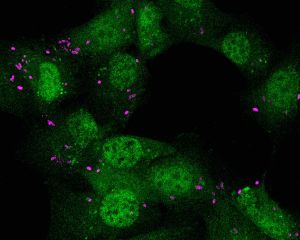
Un estudio muestra cómo el fármaco plitidepsina inhibe la reproducción del SARS-CoV-2 dentro de las células
- Actúa sobre las células e impide la formación de los espacios donde se reproduce el virus, según revela un estudio coliderado por investigadoras del CSIC e IrsiCaixa
Un estudio coliderado por investigadores del Consejo Superior de Investigaciones Científicas (CSIC) ha mostrado cómo actúa el fármaco aplidin (plitidepsina) para inhibir la replicación del coronavirus SARS-CoV-2 dentro de las células humanas: el fármaco impide la formación de compartimentos celulares donde se replica el material del virus. De este modo, interfiere en las células y evita la progresión de la infección viral. Su funcionamiento refuerza su potencial para combatir futuras variantes del SARS-CoV-2, pues este paso de la replicación del virus es común a todas las variantes del virus. El estudio, en fase de revisión, se presentó ayer en la Conferencia sobre Retrovirus e Infecciones Oportunistas (CROI), en Barcelona.
El fármaco plitidepsina, comercializada con el nombre de aplidin, ha sido uno de los fármacos que ha demostrado mayor eficacia para bloquear la replicación del SARS-CoV-2 en experimentos de laboratorio. “Cuando pusimos en marcha este estudio para analizar la actividad antiviral de plitidepsina en la célula, no esperábamos descubrir que su diana de actuación se encontraba en un estadio tan inicial de la replicación del SARS-CoV-2”, explica Cristina Risco, investigadora del Centro Nacional de Biotecnología (CNB-CSIC) y co-líder del estudio junto a investigadores del Instituto de Investigación del Sida IrsiCaixa, el Centro de Investigación en Sanidad Animal (IRTA-CReSA) y la farmacéutica PharmaMar.
El proyecto Rock-Eaters analizará cómo avanza la vida en lavas y rocas de áreas deglaciadas de la Antártida

- La expedición antártica será del 14 de febrero al 15 de marzo
- Los resultados ayudarán a analizar como contribuyen los microorganismos a la respuesta de los ecosistemas antárticos a los cambios ambientales
- Gracias a las herramientas que han desarrollado muchos de los análisis se hacen in situ, sin necesidad de llegar al laboratorio
Madrid, 10 de febrero de 2022. Cuando la lava de un volcán se enfría o por el retroceso glaciar quedan al descubierto suelos y rocas previamente cubiertas por hielo, los microorganismos son los primeros seres vivos que los colonizan. Esta colonización pionera es el paso previo e imprescindible para que se desarrollen otras formas de vida más complejas. Estas comunidades microbianas son las que se proponen estudiar en el proyecto ROCK-EATERS en el que participan Asunción de los Ríos y Fernando Garrido del Museo Nacional de Ciencias Naturales de Madrid (MNCN) y Javier Tamames del Centro Nacional de Biotecnología (CNB), ambos del CSIC. Los datos obtenidos les permitirán descubrir una diversidad antártica desconocida y caracterizar sus dinámicas para en el futuro poder valorar su resiliencia frente al cambio climático. El curso de la expedición se podrá seguir a través del blog Rock-eaters Antarctic Expedition: searching microbial life in rocks.
El recubrimiento de las nanopartículas magnéticas es clave para sus aplicaciones biomédicas
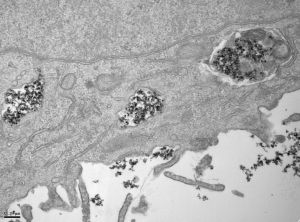
- Las nanopartículas de óxido de hierro muestran un gran potencial para numerosas aplicaciones biomédicas, especialmente para el tratamiento del cáncer
- Investigadores del CSIC identifican el recubrimiento de las nanopartículas de óxido de hierro como el principal factor que determina el tráfico y la velocidad de degradación intracelular
Madrid 4 febrero 2022. Las nanopartículas magnéticas de óxido de hierro han mostrado en la última década un alto potencial en medicina, habiéndose obtenido resultados prometedores en varias aplicaciones médicas. A pesar de estos resultados prometedores, para aprobar su uso clínico de manera generalizada es fundamental entender cómo se comportan en el interior de las células, qué rutas intracelulares activan, y cómo se degradan. Este comportamiento intracelular determinará en gran medida tanto los efectos terapéuticos de las nanopartículas como su posible toxicidad.
El nuevo trabajo de investigadores del Consejo Superior de Investigaciones Científicas CSIC liderados por Domingo F Barber y publicado en la revista Biomaterials, desvela nuevos aspectos del comportamiento intracelular de las nanopartículas. Como explica Barber, investigador en el Centro Nacional de Biotecnología (CNB-CSIC) “para su uso en aplicaciones biomédicas, las nanopartículas de óxido de hierro se recubren con diferentes tipos de moléculas o polímeros para hacerlas más biocompatibles, estables y evitar que formen agregados que podrían generar trombos. Según el tipo de recubrimiento utilizado, cuando las nanopartículas entran en contacto con el entorno biológico se producen diferentes interacciones con las proteínas del medio, afectando su tamaño final, la vía de captación celular, así como el tránsito que siguen hasta su degradación en la maquinaria celular que se encarga de este proceso (los endolisosomas)”.
Identificado un nuevo mecanismo de evasión inmune de Salmonella específico del ambiente intracelular
Identificado el mecanismo de la enzima que produce dopamina, un neurotransmisor clave para la atención, la memoria y el placer
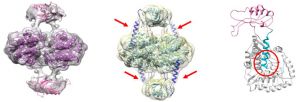
- Un equipo co-liderado por investigadores del CSIC ha aplicado la críomicroscopía electrónica para desentrañar el mecanismo de la enzima, cuya disfunción puede causar enfermedades como el párkinson
- El hallazgo sienta las bases para el desarrollo de fármacos que puedan ser de utilidad en enfermedades neurológicas
Un equipo liderado por investigadores del CSIC ha determinado la estructura tridimensional de la enzima clave para la síntesis de dopamina, un neurotransmisor (molécula que ejerce comunicaciones entre neuronas) fundamental en diversas funciones vitales cruciales en los mamíferos, como la coordinación del movimiento, la memoria y la atención, y la sensación de placer, entre otras. Se trata de la enzima tirosina hidroxilasa (TH) y conocer su estructura tridimensional es necesario para determinar tanto su mecanismo como la función que desempeña en la síntesis del neurotransmisor dopamina.
Este trabajo, publicado en la revista Nature Communications permitirá comprender el funcionamiento de esta enzima y sentar las bases para el desarrollo de reguladores farmacológicos específicos que puedan ser de utilidad en enfermedades neurológicas como el párkinson.
El equipo de investigadores, liderado por José María Valpuesta, del Centro Nacional de Biotecnología (CNB-CSIC), en colaboración con el grupo de Aurora Martínez, de la Universidad de Bergen, en Noruega, han determinado la estructura de la enzima tirosina hidroxilasa mediante la utilización de la criomicroscopía electrónica, una técnica microscópica que analiza muestras a temperatura criogénicas.
Mario Mellado: "las vacunas son muy importantes y han resuelto mucho pero no son la solución final"
La tercera herramienta para tratar la covid-19: los anticuerpos monoclonales
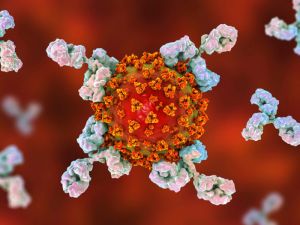
La lucha frente al SARS-CoV-2, el virus causante de la covid-19, cuenta con una nueva arma: los anticuerpos monoclonales. Estos fármacos biológicos son una opción terapéutica para pacientes con riesgo de sufrir una infección grave por coronavirus. Estos anticuerpos se suman a las vacunas y los fármacos antivirales para formar el trío de principales herramientas terapéuticas para hacer frente a la pandemia. La Agencia Europea del Medicamento ha autorizado el uso de algunos tipos de anticuerpos monoclonales. El Centro Nacional de Biotecnología (CNB-CSIC) desarrolla varios proyectos para obtener estas eficaces moléculas.
La técnica de los anticuerpos monoclonales consiste en generar anticuerpos en ratones u otros animales que han sido expuestos al SARS-CoV-2, o a partes de este, y que les han ayudado a neutralizar el coronavirus. Los anticuerpos se pueden producir luego a gran escala y pueden servir para evitar cuadros muy graves de covid-19 en la población con mayor riesgo. Serían una especie de ayudas externas a las defensas producidas de forma natural por nuestro sistema inmunitario.
XXIX Workshop Advances in Molecular Biology by Young Researchers Abroad
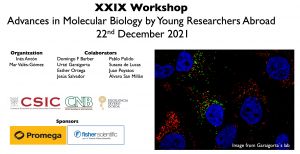
IMPORTANT ANNOUNCEMENT: This event has become virtual. If you are interested in attending, please register in the event to receive the link
A new edition of our traditional Workshop "Advances in Molecular Biology by Young Researchers Abroad" will be held next Wednesday 22nd of December.
This well stablished event has been a point of contact for scientists interested in sharing their research with the Spanish scientific community. Besides the exchange of the latest scientific advances, the conference is a unique opportubity to showcase the best young talent in the research community abroad and and promote the interaction between CNB researchers and researchers abroad.
In the afternoon we will host a round table with representatives from the Science and Innovation Ministry, CSIC and Foundation Ramón Areces, to highlight the priority strategic lines of research in Spain.
Isabel Sola: “Parte de la efectividad de las vacunas podría mantenerse frente a la variante ómicron”
COOKIES POLICY
A cookie is a text file that is stored on your computer or mobile device via a web server and only that server will be able to retrieve or read the contents of the cookie and allow the Web site remember browser preferences and navigate efficiently. Cookies make the interaction between the user and the website faster and easier.
General information
This Website uses cookies. Cookies are small text files generated by the web pages you visit, which contain the session data that can be useful later in the website. In this way this Web remembers information about your visit, which can facilitate your next visit and make the website more useful.
How do cookies?
Cookies can only store text, usually always anonymous and encrypted. No personal information is ever stored in a cookie, or can be associated with identified or identifiable person.
The data allow this website to keep your information between the pages, and also to discuss how to interact with the website. Cookies are safe because they can only store information that is put there by the browser, which is information the user entered in the browser or included in the page request. You can not run the code and can not be used to access your computer. If a website encrypts cookie data, only the website can read the information.
What types of cookies used?
The cookies used by this website can be distinguished by the following criteria:
1. Types of cookies as the entity that manages:
Depending on who the entity operating the computer or domain where cookies are sent and treat the data obtained, we can distinguish:
- Own cookies: are those that are sent to the user's terminal equipment from a computer or domain managed by the editor itself and from which provides the service requested by the user.
- Third party cookies: these are those that are sent to the user's terminal equipment from a machine or domain that is not managed by the publisher, but by another entity data is obtained through cookies.
In the event that the cookies are installed from a computer or domain managed by the editor itself but the information collected by these is managed by a third party can not be considered as party cookies.
2. Types of cookies as the length of time that remain active:
Depending on the length of time that remain active in the terminal equipment can be distinguished:
- Session cookies: cookies are a type designed to collect and store data while the user accesses a web page. Are usually used to store information that only worth preserving for the service requested by the user at any one time (eg a list of products purchased).
- Persistent cookies: cookies are a type of data which are stored in the terminal and can be accessed and treated for a period defined by the head of the cookie, and can range from a few minutes to several years.
3. Cookies types according to their purpose:
Depending on the purpose for which the data are processed through cookies, we can distinguish between:
- Technical cookies: these are those that allow the user to navigate through a web page or application platform and the use of different options or services it exist as, for example, control traffic and data communication, identify the session, access to restricted access parts, remember the elements of an order, make the buying process an order, make an application for registration or participation in an event, use security features while browsing store content for dissemination videos or sound or share content via social networks.
- Customization cookies: these are those that allow the user to access the service with some general characteristics based on a predefined set of criteria in the user terminal would eg language, the type of browser through which you access the service, the locale from which you access the service, etc.
- Analysis cookies: they are those that allow the responsible for them, monitoring and analyzing the behavior of users of the web sites that are linked. The information gathered through such cookies are used in measuring the activity of web sites, application or platform and for the profiling of user navigation of such sites, applications and platforms, in order to make improvements function data analysis how users use the service.
Management tool cookies
This Website uses Google Analytics.
Google Analytics is a free tool from Google that primarily allows website owners know how users interact with your website. Also, enable cookies in the domain of the site in which you are and uses a set of cookies called "__utma" and "__utmz" to collect information anonymously and reporting of website trends without identifying individual users..
For statistics of use of this website use cookies in order to know the level of recurrence of our visitors and more interesting content. This way we can concentrate our efforts on improving the most visited areas and make the user more easily find what they are looking for. On this site you can use the information from your visit for statistical evaluations and calculations anonymous data and to ensure the continuity of service or to make improvements to their websites. For more details, see the link below privacy policy [http://www.google.com/intl/en/policies/privacy/]
How to manage cookies on your computer: disabling and deleting cookies
All Internet browsers allow you to limit the behavior of a cookie or disable cookies within settings or browser settings. The steps for doing so are different for each browser, you can find instructions in the help menu of your browser.
If you decline the use of cookies, since it is possible thanks to the preferences menu of your browser or settings, reject, this website will continue to function properly without the use of the same.
Can you allow, block or delete cookies installed on your computer by setting your browser options installed on your computer:
- For more information about Internet Explorer click here.
- For more information on Chrome click here.
- For more information about Safari click here.
- For more information about Firefox click here.
Through your browser, you can also view the cookies that are on your computer, and delete them as you see fit. Cookies are text files, you can open and read the contents. The data within them is almost always encrypted with a numeric key corresponding to an Internet session so often has no meaning beyond the website who wrote it.
Informed consent
The use of this website on the other hand, implies that you paid your specific consent to the use of cookies, on the terms and conditions provided in this Cookies Policy, without prejudice to the measures of deactivation and removal of cookies that you can take, and mentioned in the previous section.

